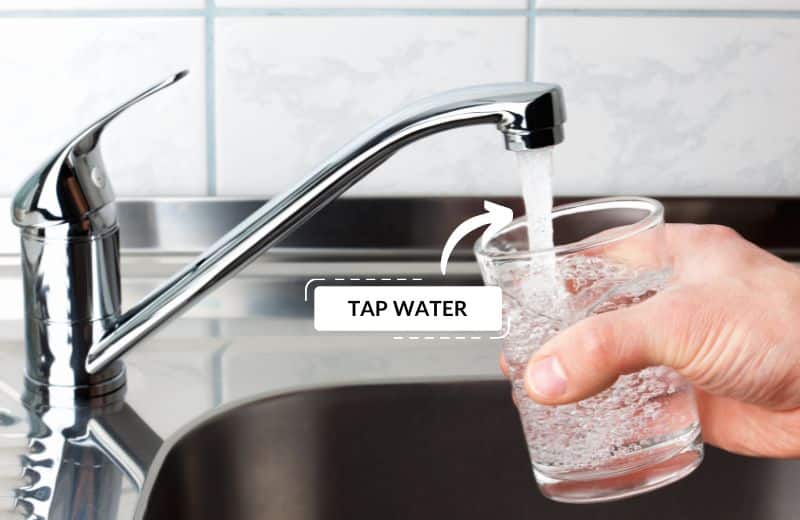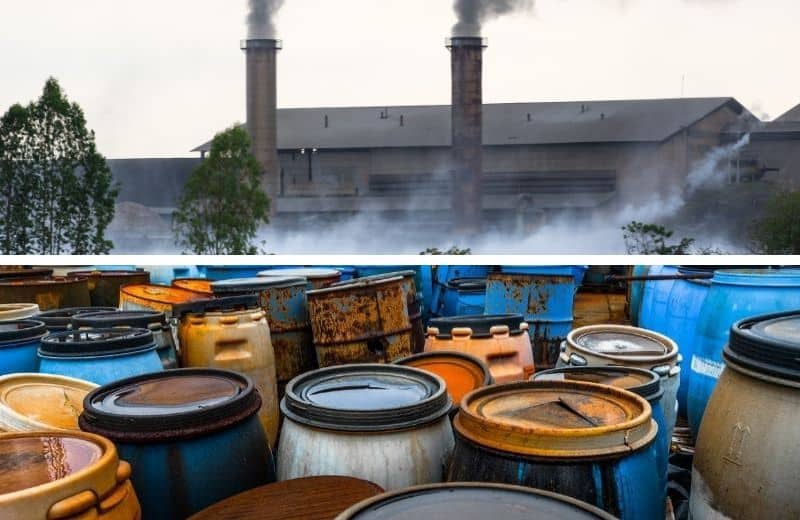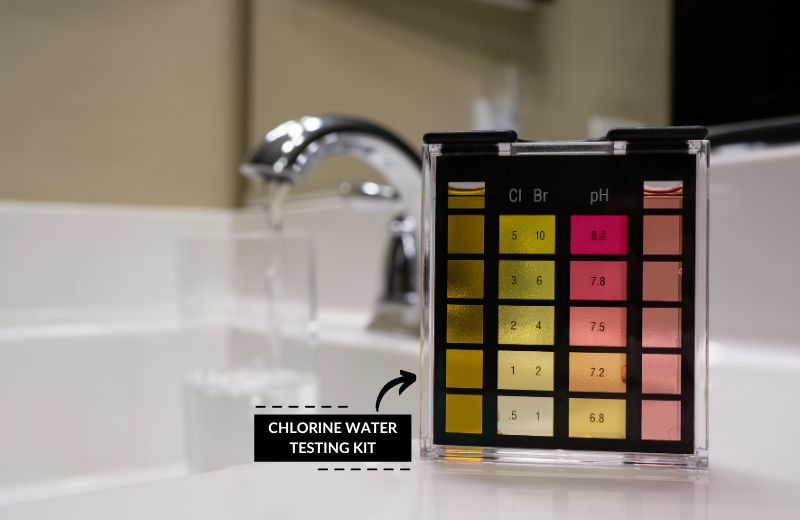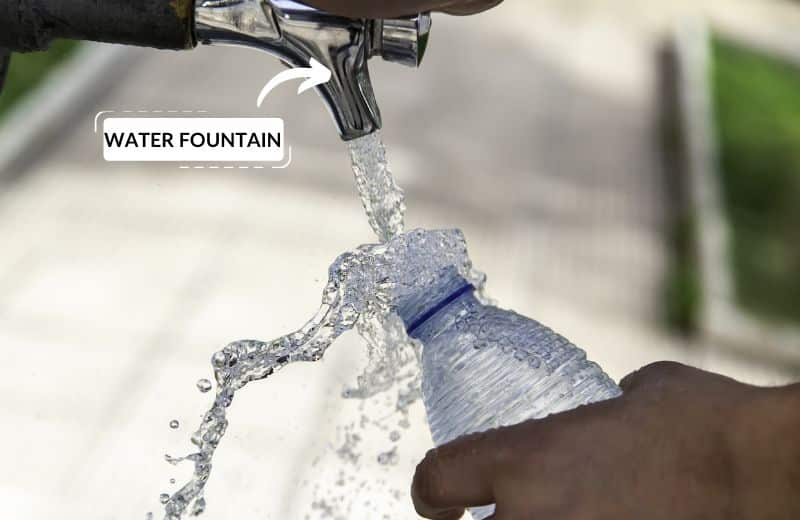Is Phoenix tap water safe to drink? What’s the water quality like? And what contaminants might you find in Phoenix drinking water? Do any of these contaminants exceed guidelines set by the EPA?
In this Phoenix tap water quality and safety guide, we’ve answered all these questions and more.
📌 Key Takeaways:
- The drinking water in Phoenix, Arizona is considered generally safe to drink.
- Phoenix’s water doesn’t currently violate any of the standards set by the Environmental Protection Agency (EPA) for public tap water safety.
- The 5 biggest problem contaminants in Phoenix tap water are disinfection byproducts, arsenic, chromium-6, nitrite, and radium – but these contaminants exist in the water below the EPA’s Maximum Contaminant Levels.
Table of Contents
- 🚰 Can You Drink Phoenix Tap Water?
- 🗺️ Where Does the Tap Water in Phoenix Come From?
- 📉 Who Regulates Phoenix Drinking Water?
- 🧪 Phoenix Annual Water Quality Report
- ☣️ Contaminants Found Above Guidelines in Tap Water in Phoenix
- 🧫 Main Contaminants Found in Phoenix Tap Water
- ⛲ Phoenix Drinking Water in Public Places
- 💬 Frequently Asked Questions
🚰 Can You Drink Phoenix Tap Water?
Yes, you can drink Phoenix tap water because the water doesn’t have any active violations of the Safe Drinking Water Act (SDWA). Like all municipal drinking water utilities, the Phoenix water utility must comply with EPA regulations – and it does, so tap water in the City is technically safe to drink.
However, being compliant with EPA regulations is not the same as being completely pure, clean, and healthy. Numerous contaminants are still detected in trace amounts in Phoenix water.
According to the EPA, low levels of these contaminants are safe in water. But the Environmental Working Group (EWG), an independent organization that’s dedicated to the research and advocacy of drinking water pollutants, believes that the EPA’s regulations are too lenient. Based on its own research, the EWG has produced Health Guidelines for various contaminants, including those that aren’t currently regulated by the EPA.
According to the EWG Tap Water Database for Phoenix, 8 contaminants exceed the EWG’s Health Guidelines and are (in the opinion of the organization) present in unsafe concentrations.

So, while the water in Phoenix is safe according to the law, the EWG believes, based on its own guidelines, that the City’s water poses a health risk.
We should also note that in the most recent EPA ECHO database, which dates from April 2019 to June 2022, the City of Phoenix water utility was found to violate the Safe Drinking Water Act in one category: Treatment Technique Violation, specifically Single Turbidity Exceed (Enhanced SWTR). This violation was resolved in January 2021 and there were no violations identified in the most recent 2022 EPA ECHO report.
Lead might also be present in Phoenix tap water, especially in old homes with lead pipes and service lines. Most of the lead pipes in the water distribution system were removed as they were discovered, with the last documented line replacement occurring in the 1990s. The biggest risk of lead contamination in the City is in homes with lead plumbing (which aren’t monitored or managed by the Phoenix water utility).
👨🔧 Looking for further reading? Our guide looks in detail at which 10 states have the worst-quality tap water.
Phoenix SDWA Violations Within 10 Years
| Period of Compliance | Resolved? | Health-Based? | Category Code | Code | Rule Code | Contaminant Code | Rule Group Code | Rule Family Code |
|---|---|---|---|---|---|---|---|---|
| 01/01/2021- 01/31/2021 | Yes | Yes | Treatment Technique Violation (TT) | Single Turbidity Exceed (Enhanced SWTR) (43) | Long Term 1 Enhanced Surface Water Treatment Rule (122) | Interim Enhanced Surface Water Treatment Rule (0300) | Microbials (100) | Surface Water Treatment Rules (120) |
| 10/01/2018- 12/31/2018 | Yes | No | Monitoring and Reporting (MR) | Monitoring, Regular (03) | Arsenic (332) | Arsenic (1005) | Chemicals (300) | Inorganic Chemicals (330) |
| 08/01/2014- 08/31/2014 | Yes | Yes | Maximum Contaminant Level Violation (MCL) | Maximum Contaminant Level Violation, Acute (TCR) (21) | Total Coliform Rule (110) | Coliform (TCR) (3100) | Microbials (100) | Total Coliform Rules (110) |
Data Source: EPA ECHO database
🗺️ Where Does the Tap Water in Phoenix Come From?
There are two primary water sources in Phoenix: surface water (supplying around 95% of the City’s water) and groundwater wells (supplying the other 5% of the water). The City’s main surface water sources are lakes and rivers, which are fed by snow melt from the mountains north and east of Phoenix.
The Phoenix water service area covers 540 million square miles and serves more than 1.5 million people. The primary water supply is obtained by the Salt River Project (SRP), which delivers water from the Verde and Salt Rivers, as well as the Central Arizona Project (CAP), which supplies water from the Colorado River.
Like all public water utilities, Phoenix conducts thousands of tests and measurements per year to continually monitor its water quality. The City tests for more than 100 water parameters and ensures that high-quality water is maintained year-round.
The collected water is then treated at one of Phoenix’s water treatment plants (there are five in total), where it undergoes the following treatment processes:
- Screening and pre-sedimentation – Water is screened to remove plant matter, fish, and other debris.
- Flocculation, coagulation, and sedimentation – Chemical coagulants are added to the water, causing particles to clump together as flocs. These flocs sink to the bottom of the sediment basin, where they can be easily removed.
- Filtration – The top surface layers of the water are then filtered using sand and gravel filters to remove lingering particles.
- Disinfection – Chlorine is added to the water to kill microorganisms and prevent recontamination in the water distribution system. Fluoride is also added for its dental health benefits.
After treatment, water enters the distribution system. It’s held in one of 70 reservoirs before being delivered to homes to meet water supply demands.

📉 Who Regulates Phoenix Drinking Water?
The City of Phoenix tap water is managed by the Salt River Project and the Central Arizona Project and is regulated by the Environmental Protection Agency (EPA), the Arizona Department of Environmental Quality, and the Maricopa County Environmental Services Department.
The EPA has established a list of regulated drinking water contaminants called National Primary Drinking Water Regulations, which all municipal drinking water suppliers – including those in Phoenix – must comply with to reduce harmful substances and ensure that water is safe to drink.
The EPA’s Maximum Contaminant Levels indicate which contaminants in water have health concerns, and the maximum levels of these contaminants that should be present in public drinking water. Water utilities must monitor and test their water to ensure compliance with these MCLs. Phoenix conducts over five million tests per year.
As well as its MCLs, the EPA has also produced a number of Health Advisories for emerging contaminants that don’t currently have an official regulation. These contaminants don’t need to be reduced or removed in water, but many water utilities take their own actions based on emerging evidence of their health effects.
The Arizona Department of Environmental Quality has a Water Quality environmental program that aims to protect public health by ensuring that drinking water systems in the City provide healthy water. The organization also protects surface and groundwater by identifying and controlling sources of pollution.
The Maricopa County Environmental Services Department monitors drinking water quality and is responsible for managing inspections, reviewing engineering plans, and ensuring compliance with national and state guidelines for water safety.
🧪 Phoenix Annual Water Quality Report
Phoenix distributes an annual Water Quality Report (or Consumer Confidence Report) every May, which contains important water quality information, including:
- The water source
- Contaminants detected in the water
- How the contaminant levels compare to the EPA MCLs
The latest Water Quality Report for the City was released in 2022 and includes information based on data collected from testing throughout 2021.
The Report shows that no contaminants were detected above EPA MCLs in Phoenix water. However, this doesn’t mean that Phoenix has exceptional-quality tap water.
For instance, 38 PPB of chromium was detected in Phoenix’s drinking water. Water containing this amount of chromium is still technically safe to drink because the EPA’s MCL for this contaminant is 100 PPB. However, you would probably rather not drink even trace amounts of chromium if you had the choice.
Some of the listed contaminants that were detected below EPA MCLs include:
- Arsenic
- Barium
- Chromium
- Chlorine
- Fluoride
- Nitrate
- Uranium
The Report also has a section dedicated to unregulated contaminants in the City’s water supply, including bromide, manganese, and HAA9. While these contaminants don’t have legal limits, it’s still useful to see their average levels in Phoenix water.
It appears that only the detected contaminants were included in this Report, so there’s no mention of harmful substances that weren’t tested for or detected in Phoenix tap water.
It’s worth noting that a Water Quality Report contains data that is only accurate within the given testing year and doesn’t account for seasonal spikes in pollution. Additionally, the EPA regulations and standards are regularly reevaluated and occasionally updated based on new evidence on the health effects of common water contaminants. Emerging contaminants may also become regulated by the EPA in the near future.
It’s a good idea to take a careful look at the most recent Consumer Confidence Report for Phoenix and research any of the contaminants that you’re concerned about. We also recommend comparing the 2022 Water Quality Report with previous reports (which you can find on the City of Phoenix website) to identify how the quality of water in the City has changed over time.
| Term | Description |
|---|---|
| Period of Compliance | Time period which a violation took place and resolved. |
| Status | Indication of the most recent compliance status of the violation. Resolved: The system has returned to compliance from the violation Archived: The violation is not yet resolved, but is more than 5 years past its compliance end date. Addressed: The violation is not resolved nor archived, but addressed through formal enforcement. Unaddressed: The violation has not been addressed, resolved, nor archived |
| Health Based | Whether the violation affects health standards. |
| Category Code | Category of violation by which it is reported. TT: Treatment Technique Violation MRDL: Maximum Residual Disinfectant Level Other: Other Violation MCL: Maximum Contaminant Level Violation MR: Monitoring and Reporting MON: Monitoring Violation RPT : Reporting Violation |
| Code | A complete description of violation codes. |
| Contaminant Code | Represents a contaminant for which the municipal water system has incurred a violation against a primary drinking water regulation. |
| Rule Code | The National Drinking Water rule. 110: Total Coliform Rule 121: Surface Water Treatment Rule 122: Long Term 1 Enhanced Surface Water Treatment Rule 123: Long Term 2 Enhanced Surface Water Treatment Rule 130: Filter Backwash Rule 140: Ground Water Rule 210: Stage 1 Disinfectants and Disinfection Byproducts Rule 220: Stage 2 Disinfectants and Disinfection Byproducts Rule 230: Total Trihalomethanes 310: Volatile Organic Chemicals 331: Nitrates 332: Arsenic 333: Inorganic Chemicals 320: Synthetic Organic Chemicals 340: Radionuclides 350: Lead and Copper Rule 410: Public Notice Rule 420: Consumer Confidence Rule 430: Miscellaneous 500: Not Regulated 111: Revised Total Coliform Rule |
| Rule Group Code | Uniquely defines a rule group. 120: Surface Water Treatment Rules 130: Filter Backwash Rule 140: Groundwater Rule 210: Stage 1 Disinfectants and Disinfection Byproducts Rule 220: Stage 2 Disinfectants and Disinfection Byproducts Rule 230: Total Trihalomethanes 310: Volatile Organic Chemicals 320: Synthetic Organic Chemicals 330: Inorganic Chemicals 340: Radionuclides 350: Lead and Copper Rule 400: Other 500: Not Regulated 110: Total Coliform Rules 410: Public Notice Rule 420: Consumer Confidence Rule 430: Miscellaneous |
| Rule Family Code | Defines the rule family code. 100: Microbials 200: Disinfectants and Disinfection Byproducts Rule 300: Chemicals 400: Other 500: Not Regulated |
☣️ Contaminants Found Above Guidelines in Tap Water in Phoenix
There are no contaminants in Phoenix water that have been found to exceed or violate standards set by the EPA. So, rather than looking at the contaminants above official EPA guidelines, we’ve focused on the contaminants that exceed Health Guidelines set by the EWG.
Just a reminder that the EWG doesn’t impose any legal standards or restrictions; its Health Guidelines are simply that: guidelines.
However, you might agree with the EWG that the EPA’s own regulations aren’t strict enough. If so, you’ll probably be interested in which contaminants the EWG deems to be present in unsafe amounts in Phoenix water.
Arsenic
Arsenic is a confirmed carcinogen and one of the most dangerous chemical contaminants in Phoenix water. 5.06 PPB (parts per billion) of arsenic was detected in Phoenix’s drinking water – that’s 1,266x the EWG’s recommended Health Guideline of 0.004. However, it’s still just over half the EPA’S legal limit of 10 PPB.

Chlorite
Chlorite is a disinfection byproduct that’s formed when chlorine dioxide and water react. Ingesting large amounts of chlorite may cause irritation of the stomach, mouth, or throat. 131.4 PPB of chlorite was detected in Phoenix water – 2.6x the EWG’s Health Guideline of 50 PPB but within the EPA’s MCL of 1,000 PPB.
Haloacetic acids (HAA5)† and Haloacetic acids (HAA9)†
As well as chlorite, two types of haloacetic acids – HAA5 and HAA9 – are commonly produced when water is disinfected with chlorine. These disinfection byproducts increase cancer risk, including the liver and bladder cancer. The HAA5 and HAA9 levels detected in Phoenix water were 12.1 PPB and 19.0 PPB respectively – between 121 and 316x the EWG’s Health Advisories of 0.1 PPB and 0.06 PPB. HAA5 has a legal MCL of 60 PPB, and the EPA doesn’t currently regulate or restrict HAA9.
Hexavalent Chromium
Hexavalent chromium, otherwise known as chromium-6, is a cancer-causing chemical that enters water sources due to industrial pollution and is difficult to remove with a standard filtration system. 0.0408 PPB of hexavalent chromium was detected in Phoenix water – 20x the EWG’s Health Guideline of 0.02 PPB. The EPA currently doesn’t regulate chromium-6.

Nitrate
Nitrate is a form of nitrogen that may cause headaches, nausea, and increased heart rate if ingested in excess. 2.25 PPM of nitrate was detected in Phoenix water, which is 16x the EWG’s Health Guideline of 0.14 PPM. The EPA’s legal limit for nitrate is 10 PPM.
Radium (-226 & -228)
Two radiological contaminants detected in Phoenix water were radium -226 & -228. If you drink tap water containing excess radium, you may experience long-term health effects including cancer and anemia. 0.11 pCi/L (picoCurie per liter) of radium was detected in Phoenix water, which is 2.2x the EWG’s Health Guideline of 0.05 pCi/L – but still within the EPA’s MCL of 5 pCi/L for this contaminant.
Total trihalomethanes (TTHMs)†
Trihalomethanes (TTHMs) are another type of disinfection byproduct found in municipal water supplies. In Phoenix water, 41.5 PPB of TTHMs were detected – 276x the EWG’s recommended Health Guideline of 0.15 PPB. The EPA enforcement for this drinking water contaminant is 80 PPB.
As is the case with most municipal drinking water supplies, the biggest contaminants of concern in Phoenix water are disinfection byproducts. Many of these byproducts are an unavoidable outcome of chlorine disinfection – and many aren’t regulated by the EPA, which is why they’re so commonly present in public tap water in the US.

🧫 Main Contaminants Found in Phoenix Tap Water
We know which contaminants are found in the highest quantities in Phoenix water. But are there any other contaminants present in smaller quantities?
Below, we’ve listed the main contaminants found in acceptable levels (according to both the EPA and the EWG) in Phoenix tap water:
- Barium – A naturally occurring metal that gets into water when barium-containing rocks break down and dissolve; may cause nausea, vomiting, diarrhea, abdominal cramps, difficulty breathing, blood pressure fluctuations, and muscle weakness if large quantities are consumed.
- Bromate – A disinfection byproduct produced when ozone disinfectants react with naturally occurring bromide in water; may cause nausea, vomiting, diarrhea, abdominal pain, and kidney effects if ingested in excess.
- Chlorate – Another disinfection byproduct produced when chlorine reacts with organic materials in the water; may increase cancer risk and cause liver damage if consumed in excess.
- Germanium – A chemical element that exists naturally in water and foods; consuming high concentrations of this contaminant could cause kidney damage, kidney failure, and death.
- Manganese – A water hardness mineral that often occurs naturally alongside calcium; doesn’t cause health problems at normal levels but is known to cause scale build-up, dry skin and hair, poor lathering with soap, and other water hardness effects.
- Selenium – A non-metal elementthat gets into water from natural deposits, discharge from mines and refineries, and agricultural runoff; may cause numbness in fingers and toes, hair and fingernail loss, and circulation problems if ingested above the EPA’s MCL.
- Strontium – A heavy metal that gets into water due to natural dissolving from rocks, mining, and manufacturing operations; doesn’t pose a health risk at low levels but may cause cancer if consumed in excess.
- Total chromium – Refers to all the chromium compounds in water, including chromium-3 and chromium-6; the most harmful form of chromium is chromium-6, which may cause cancer and liver damage when ingested in large amounts.
- Vanadium – A metal that occurs naturally in rocks and soils and may leach into water through erosion or from fossil fuel deposits; safe to ingest in low levels in drinking water.
- Total xylenes – VOCs that are found naturally in coal, wood, tar, petroleum, and some plants; excess xylene contamination may cause liver and kidney damage, disorders of the central nervous system, and coordination and balance issues.
⛲ Phoenix Drinking Water in Public Places
We know that we can drink tap water at home in Phoenix – but what about the City’s public water in bars, hotels, and restaurants? How does public water differ from Phoenix’s tap water?
Actually, the tap water in public places should be the same as the water that comes out of your faucets at home. Like most Cities in the US, Phoenix offers free tap water on request in restaurants and bars. However, some restaurants may decline to offer you free water if you haven’t paid for another drink (it just depends on the restaurant in question).
Hotels should also have free water on tap that’s the same as your water at home. The exception is a few old hotels that might not have safe drinking water in their rooms. Check with the staff at the reception desk if you’re unsure.
You don’t have to drink public water in Phoenix if you prefer not to. Most stores sell bottled water from popular brands like Aquafina and Dasani.

💬 Frequently Asked Questions
How does Phoenix clean its water?
Phoenix cleans its tap water in treatment centers, combining physical filtration with disinfection to remove contaminants and make the water microbiological safe to drink. Chlorine is the most commonly-used disinfectant in Phoenix tap water. Chlorine is a popular choice for large-scale water disinfecting because it’s cheap and easily accessible, but it’s known to react with organic matter in water and produce disinfection byproducts.
How is the water quality in Phoenix?
The water quality in Phoenix is good. The latest Consumer Confidence Report for Phoenix shows that the City’s drinking water complies with guidelines set by the EPA, meaning that no contaminants are present in quantities higher than the EPA’s MCLs. However, contaminants are still present in trace amounts in Phoenix tap water, and you might prefer not to drink them at all.
Is Phoenix water supply at risk?
There is contesting information online about whether or not Phoenix’s water supply is at risk. AZ PBS says that Arizona (not Phoenix specifically) is facing a serious water shortage, but that Phoenix has introduced numerous projects to mitigate this problem. Another source – the City of Phoenix – says that Phoenix’s water supply is in “very good shape” and doesn’t depend on annual precipitation events.
Does Phoenix tap water have fluoride?
Yes, Phoenix tap water has fluoride. The City adds a small amount of its synthetic (artificially made) fluoride to its tap water to support customers’ dental health and reduce costs associated with dental visits. Fluoride is known to protect the tooth enamel, but large amounts of this mineral may cause health problems like dental fluorosis (tooth discoloration) and skeletal fluorosis, and some folks believe that ingesting even low levels of fluoride may be dangerous.
What contaminants are in Phoenix water?
Phoenix water contains contaminants including arsenic, chromium-6, disinfection byproducts, nitrate, and radium. None of these contaminants are present in levels that exceed EPA guidelines – but if you’d prefer not to drink them, you can filter them out with a good water filtration system.
Is Phoenix tap water hard or soft?
Phoenix tap water is in the hard or very hard range, depending on the exact water source. The groundwater in Phoenix is likely harder than the surface water because groundwater has seeped through layers of calcium-rich rock to reach the aquifer, giving more opportunity for hard minerals to leach into the water. You might notice hard water effects like scale build-up, dry hair and skin, and poor lather with soap at home.

